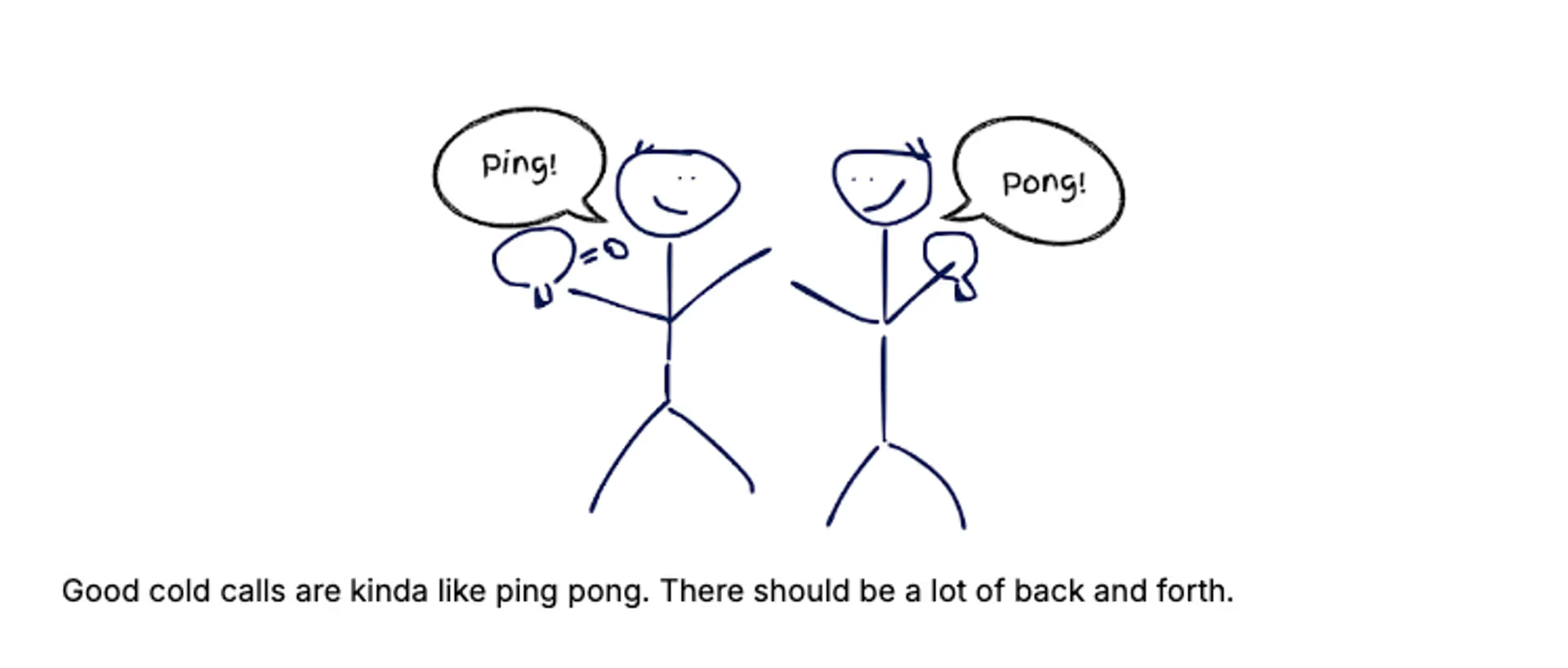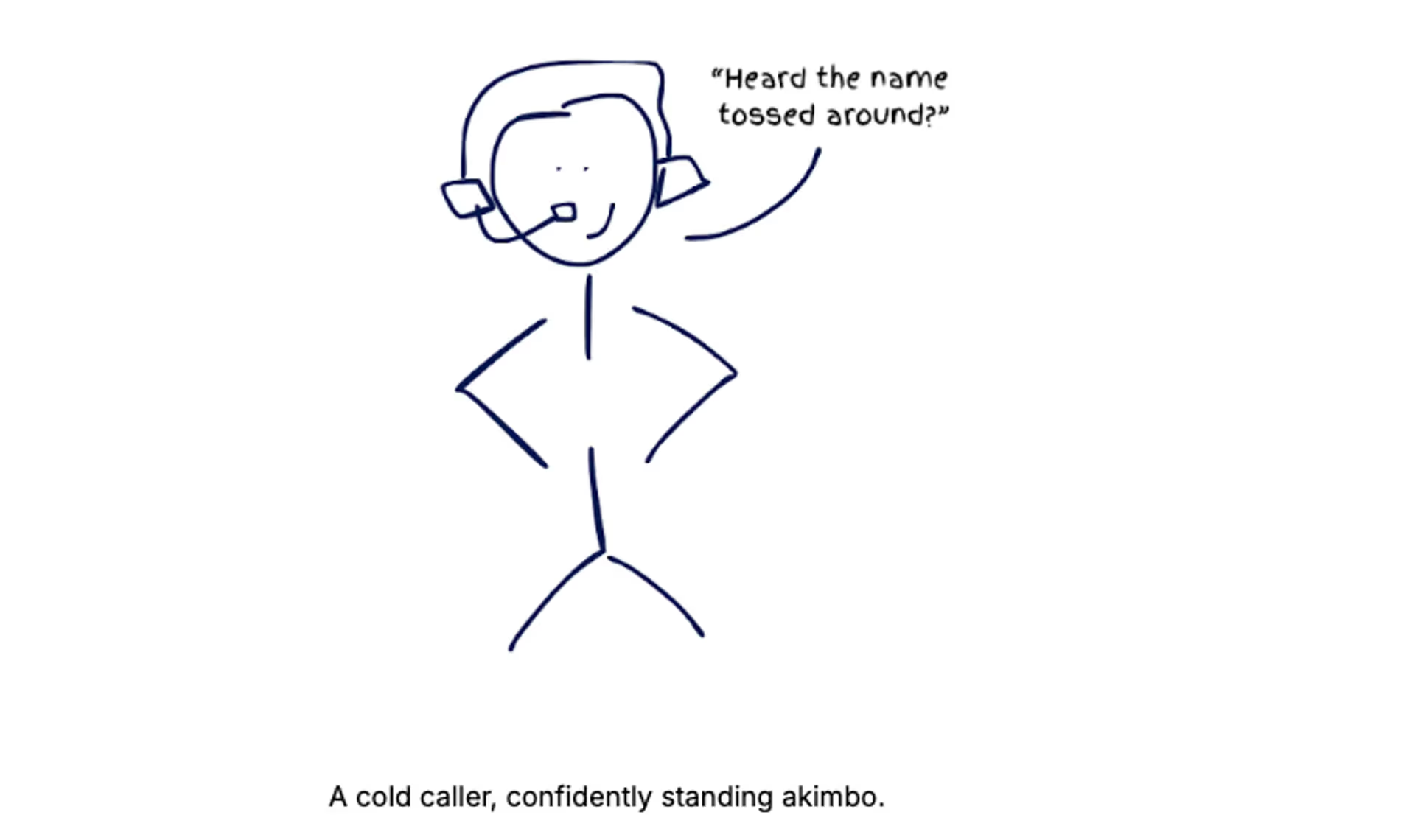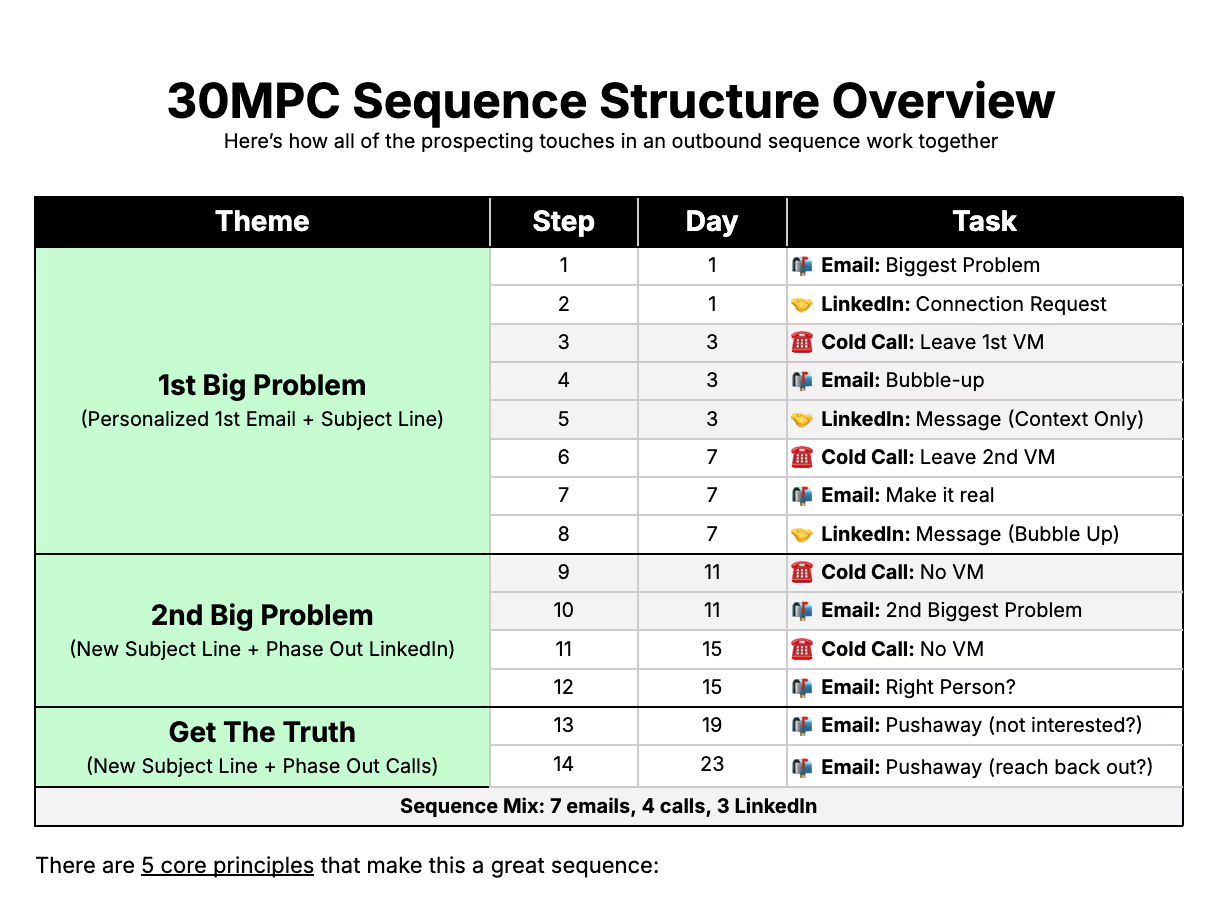If you’re reading this, someone probably told you to make some dials… and it ain’t workin’ yet.
The keyword here is “yet.”
You might be coming to this toolkit because, like me, when I first started dialing, someone handed you a virtual phone and mandated you to make X number of dials with the expectation that you’d magically book a bajillion meetings a month.
You, like a past version of me, tried your best. And you, like that past me, have come up short.
Who’s me, you might ask?
Sarah Brazier, co-founder of Dimmo, President’s Club Winner (as an SDR & AE), and meeting booker with a penchant for the phone.
I’m teaming up with my buddies at 30 Minutes to President’s Club and Orum to break down the most common mistake that sellers forget when they’re cold calling:
They forget how to be an actual human.
We’ll break it down into four tactical steps:
- The Mindset
- How to Have Them at Hello (aka, the opener)
- Ditch the Pitch (aka, the value proposition)
- “It’s Not What You Say… It’s HOW You Say It” (aka, the tone)
Let’s roll!
#1 MINDSET, BABY.
“Oh, jeez, another iNfluEncEr telling me to cold plunge,” may be your knee-jerk reaction when you read the word “Mindset” as the first tactic for cold calling like a human.
I get it. It’s a dead horse that’s been kicked in every way possible. But it wouldn’t be a cliche if it didn’t have at least some truth to it.
The reality is your mindset directly impacts your call outcomes.
If you wake up in the morning, look at your to-dos, and say to yourself, “Gosh, I hate cold calling. It never works. It’s such a waste of time. I’d rather sit in an ice bath with Gary V…” then there’s a high probability that:
- You will psych yourself out
- You will avoid cold calling
- When you do cold call, your discomfort will be audible to your prospect (more on that later)
- You will waste time doing things other than cold calling
So, to put yourself in the brain space to make cold calls, it’s best to cut the negative self-talk and instead realize that your ability to cold call does not reflect your worth as a human being. The point of making cold calls is not to book meetings but to start conversations.
If you remove the pressure of the outcome and instead focus on finding a problem that your prospect is struggling with, you can help them solve, so the natural outcome is a meeting. Other times, you learn they actually don’t have any issues, so the natural outcome is pleasantly hang up and move on.
And when you remove that pressure, you’ll be shocked that cold calling can actually be… fun.
#2 How To Have Them At Hello

Now that you’re feeling good about picking up the phone, it might be good to know what to say when your prospect decides to answer it.
Below are some ideas around what you can say to start a call, but I will caveat it with this:
Use what works for you.
If your opener feels and, more importantly, sounds TOTALLY unnatural every time a prospect picks up the phone to the point where most of your calls end in the first 10 seconds with a *click* and a dial tone, then, yeah, try something different.
Now, let’s start with what *not* to say:
“Hi, this is Sarah. How’s your day?”
“Hi, this is Sarah. Is now a bad time?”
These openers are platitudes that lump you in with the rest of the telemarketers. The moment your prospect hears them, they immediately stop listening.
So, what should you say instead?
Armand and Nick recommend two openers in their book: a “Tailored” Permission-Based Opener or “The Heard the Name Tossed Around” Opener.
Let’s start with a traditional permission-based cold call opener.
I like this technique because it allows the prospect to OPT IN to the call instead of being thrust into a conversation they don’t want to have. By acknowledging their autonomy, you’re reminding them that you see them as a human:
Hey, this is Sarah Brazier. I know no one likes a cold call, especially on a Monday morning, but I think you will want to hear this.
Do you mind if I share why I’m calling, and then you can tell me if it’s a conversation worth having?”
And if you want to add personalization upfront, that makes it even more human and turns it into a Tailored Permission Opener:
Hey, this is Sarah Brazier. I noticed you were hiring an Enterprise SDR – I know no one likes a cold call, especially on a Monday morning, but I think you’re going to want to hear this.
Do you mind if I share why I’m calling, and then you can tell me if it’s a conversation worth having?”
Next, let’s move to the “Heard The Name Tossed Around” Opener.
The idea is you lead with context about how you work with other folks like them before ever uttering your name (or your company’s name).
There are three steps, which sound like this:
[Context]: Hey, Carol, I've been working with Suzy and Phil over at Canva Australia.
[Intro] “It’s Sarah from Dimmo…”
[Question]: “Heard the name tossed around?”
The results are they’ll either say YES, it DOES ring a bell, in which case you can
- Ask about their familiarity
- Ask about challenges
- Ask them about… THEM
And if they say NO, you can
- Provide context via a pitch (which leads me to my next point…)
But either way, when you lead with context, you sound like a human (instead of a spam caller).
#3 Ditch the Pitch
In a typical cold call, once a salesperson has finished the opener, they go straight for the pitch.
Technically, there’s nothing wrong with this. If it’s working for you, great. If not, it probably boils down to the fact that most pitches are too long, jargon-filled, feature-focused, and kind of boring… which leads your prospect to immediately glaze over, tune you out, and hang up.
My recommendation? Instead of monologuing about features and benefits, break up the pitch into parts that generate an actual conversation (you know, something HUMANS do).
Here are the components of a typical pitch:
- Start by describing the status quo.
- Challenge the status quo - a la, why the current way of doing things broken.
- Introduce a solution.
- Back it with a customer story.
- Ask for relevancy.
Here’s what that might sound like:
[1] Many sales leaders I’m talking with share that top-of-funnel is getting increasingly hard. In conjunction with Google and Microsoft making it harder for cold emails to land in a prospect’s inbox, AI that was supposed to increase bookings is overwhelming buyers with spam, causing them to tune out pretty much everything.
[2] As a result, sales leaders are doubling down on cold calls but not necessarily seeing the results. Not all prospects are created equal: some have a higher propensity to pick up the phone than others, but sales reps don’t discriminate when they dial down a list, wasting a ton of time AND money.
[3] That’s why Orum rolled out two new products that help salespeople get connected: Boost Connect and Hot Numbers. They use sophisticated algorithms to ensure your phone number won’t be flagged as spam and optimize your list to dial phone numbers that pick up.
[4] Orum customers are seeing an average boost in connect rates of 18% with Boost Connect and a 4x increase in connect rates with Hot Numbers.
[5] Is this relevant to you?
So, yeah, this is a MASSIVE wall of text. It’s all REALLY good info for your prospect (and it kind of makes you want to buy Orum, right?), but it’s too much at once and doesn’t allow your prospect to get a word in edgewise.
The solution: Break up your pitch into parts by inserting questions at the end of each component.
Here’s what that could look like:
Start by Describing the Status Quo:
“Many sales leaders I’m talking with share that top-of-funnel is getting increasingly hard. In conjunction with Google and Microsoft making it harder for cold emails to land in a prospect’s inbox, AI that was supposed to increase bookings is overwhelming buyers with spam, causing them to tune out pretty much everything.”
Confirm this is something your prospect is dealing with:
"Are you seeing something similar in the field?”
LET THEM TALK, then follow up with a question
Dig deeper:
"Oh, really? How’s that impacting your bookings?”
LET THEM TALK, then…
Challenge the Status Quo:
“Gotcha, yeah. I’ve heard the same thing from a lot of my customers. We actually started digging into the root cause of low connect rates, and we found that many outbound cold calls are being flagged as spam. On top of that, reps are dialing down lists indiscriminately, not knowing who is more likely to pick up."
LET THEM TALK, then…
Ask if this is a problem they’re aware of / trying to solve:
“Do you know if your numbers are coming up as spam when reps call?”
…or…
“Are you using anything to help reps know which prospects are more likely to answer the phone?”
LET THEM TALK, then…
Introduce a solution:
“Yeah, most of my customers actually don’t know if their numbers are being flagged as spam, and they don’t have any data to help target their lists… that’s actually why I’m calling. At Orum, we help you do both with some pretty sophisticated tech. We ensure your phone number won’t be flagged as spam and optimize your list to dial phone numbers that actually pick up.”
Back it with a customer story:
“Our customers are seeing an average boost in connect rates of 18% with Boost Connect alone and a 4x increase in connect rates with Hot numbers.
Ask for interest:
“Does that sound like something you’d be interested in?”
> LET THEM TALK

Why does this work?
- First, it gives you the option to pivot. If, for example, the prospect is not struggling with numbers being flagged as spam, you can ask them what they are struggling with. If they have a solution, you can ask them what they’re using and tweak your pitch to differentiate from a competitor.
- Second, it gives you TONS of information about the prospect’s current state, level of pain, and overall qualifications to even be a customer. When the conversation concludes, you will feel confident that their “no” is very real or their “yes” makes them extra qualified.
- Third, it’s HUMAN. You spent way less time talking about yourself and way more time asking them about THEM. You had a dialogue—a back-and-forth! You did not drone on and on about a piece of technology but asked about their work, processes, and problems.
When you show genuine interest in a prospect, they are FAR more likely to like you and, therefore, spend more time talking to you.
#4 It’s Not What You Say, It’s How You Say It
Before entering sales, I spent most of my 20s in the theater world. I acted in shows, took classes, and coached and trained students. So, I’ve spent a ton of time thinking about and/or working on making scripted words sound human.
In theater, the job is transforming written words into believable, 3D, living, breathing human beings on stage.
One of the easiest ways to not sound like an actual human on a cold call is to sound like you’re reading from a script.
But at the same point in time, having a referenceable document on what to say is incredibly helpful - especially when you’re first starting out.
So, if you do use a script or reference doc, please do yourself a favor and listen to yourself on the phone. Most people hate the sound of their own voice, but you’ll be shocked how different you sound on a cold call versus in real life:
- Tone: How do you sound? Happy? Relaxed? Or do you sound uptight or overly serious? Are you talking so fast that the prospect can’t keep up?
- Word Emphasis: What words are you emphasizing?
- Pacing: When you start to pitch does it sound like something you memorized in 3rd grade? Are zipping through, or more like you’re describing something in the moment as it pertains to what the customer has already shared about themselves?
Vibe check yourself. Take some notes, and then, try some of the below tips to make adjustments.
1. Smile.
I know, I also hate it when strangers tell me to smile. But, when it comes to cold calling, it’s kind of a must. Our prospects can HEAR a smile through the phone (try it, you’ll see). Smiles induce likability and trust, which are critical in the first 10 seconds of a cold call. So, do yourself a favor and turn the frown upside down.
2: Stand up.
Standing up gives your voice energy because it allows your diaphragm to support your breath fully. Better breath support = better air movement = a more energetic-sounding voice. If you’ve ever caught yourself running out of breath on a cold call due to nerves, this is something you should start doing.
3: Power Pose.
In speaking of being nervous while dialing, this one should help alleviate some nerves. I learned this in an acting class: when we create the image of an emotion with our bodies, our bodies will begin to experience that emotion. So, if you want to project confidence - stand akimbo (like Peter Pan or Superman) - and you will actually start to feel more confident. That feeling will come across in your voice on the phone. In the same way, if you’re sitting down, laying your head on your desk while you listen to dial tones, you'll feel despondent, bored, and sad. And when a prospect picks up? They’ll hear those negative vibes in your voice.

4: Breathe.
Similar to power posing, breath helps us create and control emotions. I taught myself how to cry at the drop of a hat by focusing on what my breath does when I cry (shallow breathing that turns into hyperventilating, holding my breath at the top of each breath, and having a shaky exhale).
Next time you’re feeling ultra-relaxed, hone in on what your breath is doing. You’ll probably notice long inhales and exhalations, the corners of your lips turned slightly upwards, and your eyes crinkling in the corners ever so slightly. Before you start your next call blitz, take a minute to breathe like this, and you’ll notice how it impacts your mood and your tone of voice.
5. Record yourself and fix one thing at a time.
In terms of tone of voice, how did you sound when you listened to yourself on the phone? Nervous and overly chipper? Like you were pushing too hard? Or serious and annoyed, like you didn’t want to be on the phone at all? If you start implementing power poses and breath work, you will find your voice naturally relaxes - helping you sound welcoming and calm. Record yourself delivering a couple of your go-to lines (be it your opener, a probing question, or a default objection handle when you get a brush-off), trying different inflections and emphasis to figure out what sounds good.
6: Control your pacing.
A lot of times, when we’re nervous, we talk faster. When we’ve said the same thing repeatedly, we also talk faster. Cold calling is a lot of repetition to speed through our talk tracks. Even though we’ve said these lines 10 times today, our prospect is probably hearing it for the first time. So, go slow. Breathwork and power posing will naturally help you do this, but if you catch yourself speeding up or getting brushed off by the prospecting, just remember: go slow.
These are just a couple tips to help you sound more human on the phone. If you’re really struggling to master how you sound, do yourself a favor and take an acting or improv class. First off, it’s really fun, and will 1,000% boost your confidence. Second, It will go worlds beyond any toolkit, packet, or book.
But Wait, There’s More…
While this toolkit functions as a guidepost to cold-calling success, the reality is that there’s always more we can do as sellers to improve.
The key is to take it one step at a time. Today, it might be improving your attitude toward cold calls. Tomorrow, it could be refining your pitch framework to foster better conversation. Whatever you do, pick one thing to improve, and make that the focus of your cold call game that day.
And with that, my friends, let’s hit the phones.

















